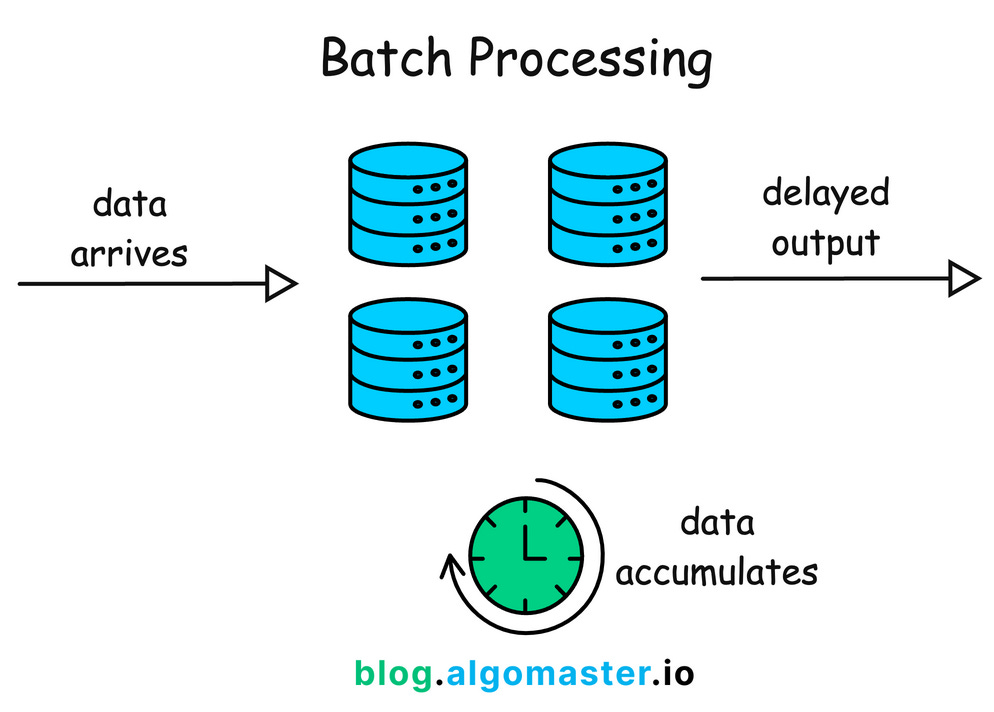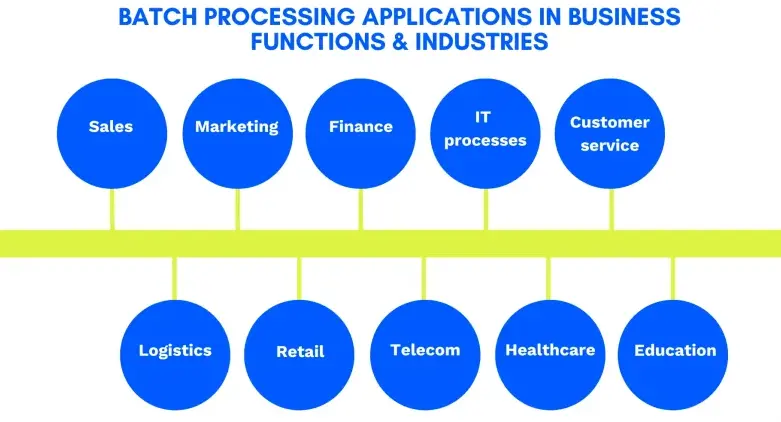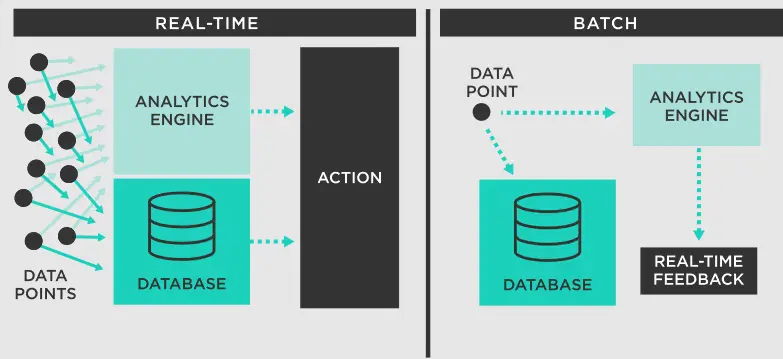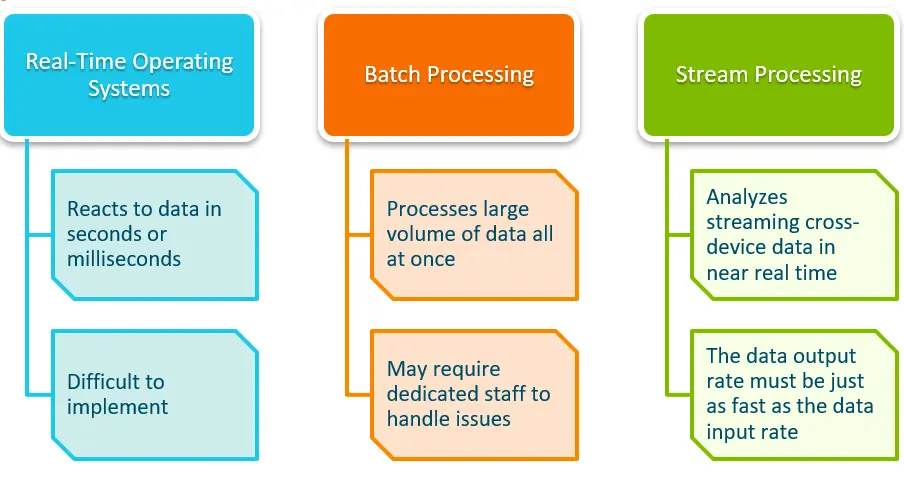What is Batch Processing?
Batch processing is a method of computing where a set of tasks or jobs are processed together in a batch process, without any manual intervention. The tasks are grouped and executed sequentially, allowing for efficient and automated processing of large volumes of data.
Batch process jobs are collections of tasks or processes that are executed together as a group. These batch processing jobs are scheduled to run at specific times or intervals, and they often involve processing large amounts of data.
Batch process jobs can be designed to perform various operations such as data extraction, transformation, and load (ETL), report generation, data backups, and more.
What Does "Batches" Mean in Batch Processing?
The batches meaning in batch processing is to organize and streamline data handling, optimizing resources for businesses and technology systems alike.
Here’s a breakdown of batches meaning:

Definition of Batches in Batch Processing
In batch processing, the batches is defined as a group of data items or tasks collected and processed together.
Rather than processing data immediately as it comes in (as in real-time processing), batch processing waits until a significant amount of data accumulates.
This method is especially effective for tasks like payroll processing, bank transaction updates, and inventory management.
Batches Meaning in Business
For many businesses, batches meaning is meant to improve efficiency and reduce operational costs. By grouping similar tasks or data, companies can streamline processes, allocate resources effectively, and reduce repetitive work.
For instance, a company might process all daily orders overnight in one batch rather than handling each order individually.
Applications of Batch Processing
Batch processing executes data in groups or "batches," and streamlines workflows by applications. Batch processing def finds applications in various industries and scenarios, including:

- Banking and Finance: Batch processing is used for tasks like transaction processing, account reconciliation, and generating financial reports.
- Manufacturing: The batch process is utilized for activities such as inventory management, production planning, and quality control.
- Data Warehousing: Batch processing is employed for updating and maintaining the data warehouse by extracting, transforming, and loading data from various sources.
- Telecommunications: The batch process is used for call detail record processing, billing, and network optimization.
- E-commerce: Batch processing is employed for inventory management, order processing, and generating customer reports.
When to Use Batch Processing?
Batch processing enhances data management and automation efficiency, making it ideal for businesses to use. Batch processing is most suitable when:
- Large volumes of data need to be processed without human intervention.
- The processing tasks can be executed sequentially without real-time constraints.
- There is no immediate need for real-time response or feedback.
- Processing can be scheduled during off-peak hours to minimize performance impact on other systems.
By utilizing batch processing capabilities, organizations can achieve increased efficiency, reduce manual intervention, and effectively handle large-scale data processing tasks.
How Does Batch Processing Work?

Batch processing is a powerful method for managing and executing groups of similar tasks without user interaction. In this section, we'll shed light on how batch processing functions.
- Gathering of Tasks: Batch processing starts with the collection of tasks. These tasks are similar and do not require user interaction during processing. All instructions are pre-defined.
- Grouping into a Batch Process: The collected tasks are grouped to form a batch process. This creates a large pool of processing jobs that can be executed all at once.
- Scheduling the Batch Process: A specific time is set to execute the batch. This is often done during off-peak times when the system has lower levels of utilization, such as overnight.
- Running the Batch Process: At the scheduled time, the system begins processing the batch. The tasks are executed sequentially, one after another without any manual intervention.
- Error Checks: If an error occurs during processing, the batch processing system either flags the issue for manual resolution or moves on to the next task if the issue isn’t critical.
- Completion and Review: Upon completion, a report is generated summarizing the batch execution, including any issues encountered. This report aids in reviewing the effectiveness and reliability of the batch process.
Components and Processes Involved in Batch Processing
Understanding the Batch processing’s components and processes is crucial for optimizing workflow and resource utilization, especially in automated environments.
In this section, we'll delve into the key components and processes of batch processing.
Components of Batch Processing
The components of batch processing are the following:
- Job Scheduler: Coordinates and prioritizes the execution of tasks based on predetermined factors such as dependencies, time, and resource availability.
- Job Queue: Stores and organizes incoming tasks or jobs in an orderly manner, waiting for their execution call from the job scheduler.
- Batch Monitor: Evaluates the progress and performance of executing tasks, ensuring smooth and error-free operation.
- Batch Processor: Responsible for executing tasks or jobs, following the schedule and order determined by the job scheduler.
- Scripts and Programs: The actual tasks or jobs to be processed, often written in languages such as Python, Shell, or Java, which execute various commands or operations.
Processes Involved in Batch Processing
The processes involved in batch processing are the following:
- Data Input: Collecting and organizing data from various sources to be used in the batch processing tasks.
- Batch Job Preparation: Defining the tasks or jobs through scripts, programs, or commands, ensuring that they are formatted correctly and free of errors.
- Job Scheduling: The job scheduler arranges the tasks based on factors such as priority, dependencies, and resource availability.
- Processing Execution: The batch processor executes the tasks in the defined sequence, processing the data as per the requirements of the job script.
- Monitoring and Error Handling: The batch monitor observes the progress of the tasks, dealing with any errors that may arise during the execution process and ensuring efficiency.
- Output and Reporting: Upon completion, the results or outputs of the tasks are saved and communicated to the appropriate recipients, such as stakeholders or other systems.
Understanding the various components and processes of batch processing empowers businesses to automate repetitive tasks. Thus resulting in improved efficiency, reduced errors, and optimized resource allocation.
Comparison of Batch Processing with Other Data Processing Techniques
In this section, we'll assess batch processing against other popular data processing techniques considering their use cases, advantages, and potential drawbacks.
Batch Processing
Batch processing involves executing a series of tasks (or jobs) grouped without human intervention.
This method excels when dealing with large amounts of data that don't require immediate processing, making it a cost-effective and time-efficient solution.
However, it lacks real-time processing capability, which can be a drawback for applications needing instant insights or responses.
Real-Time Processing

Unlike batch processing, real-time processing ensures results are delivered almost instantaneously upon data input.
This makes it a great fit for applications where real-time responses are crucial, such as flight control systems or online payment gateways.
However, real-time processing demands more resources and might not be the best choice for large datasets due to potential performance issues.
Online Processing
Online processing relates to executing tasks the moment they are issued, providing users with immediate feedback.
Similar to real-time processing, it provides quick results, making it valuable for tasks that require user interaction.
Nevertheless, it might encounter difficulties performing complex calculations or handling hefty datasets, as it's predominantly designed for speed and responsiveness.
Distributed Processing
Distributed processing involves processing data across multiple computers or servers. It improves processing speed and system reliability, especially for larger datasets or more complicated tasks that can be parallelized.
However, it requires more coordination and can face issues such as network latency or system failures, which aren't concerns for batch processing.
Stream Processing

Stream processing involves processing data in real-time as it arrives. It's optimized for handling continuous data streams, providing timely insights for applications like financial monitoring or social media trend analysis.
Like real-time processing, it requires significant resources and may not be efficient for larger, non-continuous datasets.
Final Output
Batch processing and other data processing techniques serve different purposes. The choice of the method depends on the specific requirements of the task, such as the data volume, real-time needs, resources, and result delivery time.
Understanding these distinctions enables businesses to choose the right processing technique, thereby maximizing their data potential.
Advantages of Batch Processing

In this section, we'll delve into the benefits of utilizing batch processing for data management and computation, providing insights into its efficiency and effectiveness.
High-Volume Task Efficiency
Batch processing is optimized for efficiently handling high-volume tasks by processing sizable data chunks.
This makes it ideal for managing operations like backups, sorting, and filtering, especially when dealing with large data sets.
Cost-Effectiveness
When executing large-scale data operations, batch processing def proves to be cost-effective by reducing the computational requirements and storage expenses compared to other methods, such as stream processing.
Automated Processing
Batch processing streamlines operations by automating recurring tasks without constant user intervention.
This allows for more efficient processing and reduces human error in routine tasks.
Flexible Hardware and System Requirements
Organizations with varying computational capabilities can benefit from batch processing, as it doesn't necessitate high-end hardware or sophisticated system support, making it accessible and budget-friendly.
Offline Capability
A key advantage of batch processing systems is their ability to operate offline. This ensures continuous operations, even during network downtime or in environments with limited internet connectivity.
Improved Resource Management
Batch processing fosters better resource management by scheduling operations during off-peak hours or periods of low system usage. This helps balance the workload and prevents overburdening the system during peak times.
Limitations of Batch Processing
In this section, we'll discuss the limitations associated with batch processing, shedding light on potential challenges businesses may face when utilizing this approach for data management and computation.
Lack of Real-Time Processing
Batch processing involves accumulating and processing data in sizable chunks or batches. Because of this, real-time processing and analysis are not feasible, which could hamper immediate decision-making or time-sensitive tasks.
Longer Processing Times
Depending on the batch size and complexity of the tasks, batch processing can result in extended processing times, particularly when compared to real-time or streaming methods.
This may lead to slower data and insights delivery, thereby potentially impacting critical business decisions.
Less Flexibility
Batch processing is typically a rigid process, with predefined schedules, data intervals, and computational procedures.
This lack of flexibility may limit an organization's ability to adjust or fine-tune its data processing strategy based on dynamic requirements.
Resource Intensive
Executing batch processing tasks usually necessitates high computing power and resource allocation for data storage and processing.
This could pose challenges in effectively managing and allocating resources, especially for organizations lacking significant computational capabilities.
Reduced Data Currency
As batch processing involves the accumulation of data over time, the freshness or currency of data may be compromised.
This means insight derived from earlier points in time may no longer accurately reflect current situations or customer behavior.
Increased Error Propagation Risks
Errors in a batch process can have cascading effects, sometimes compromising the entirety of the processed data or even halting the entire operation.
This could lead to prolonged downtimes or necessitate reruns, impacting efficiency and the delivery of insights.
Frequently Asked Questions (FAQs)
What is batch processing?
Batch processing is a technique used for processing large volumes of data in batches. As per processing def data is collected, processed, and stored for future analysis or decision-making.
Does batch processing provide any benefits?
Batch processing offers cost savings, eliminates human error, and provides alerts. It also allows for scheduling and improves efficiency and accuracy in data processing tasks.
What are the drawbacks of using batch processing?
Batch processing can result in delayed processing time, long processing times, and unpredictable results, and may not be suitable for continuous processing def or real-time decision-making.
What is the organizing process of batch processing?
Batch processing can be scheduled using built-in schedulers, cron jobs, or third-party scheduling tools. Scheduling allows organizations to optimize resources and minimize the impact on other systems.
Is batch processing still relevant in the future?
While advancements in technology are driving alternative methods like real-time or stream processing, processing def remains relevant due to its cost-effectiveness, accuracy, and suitability for certain applications and industries.

